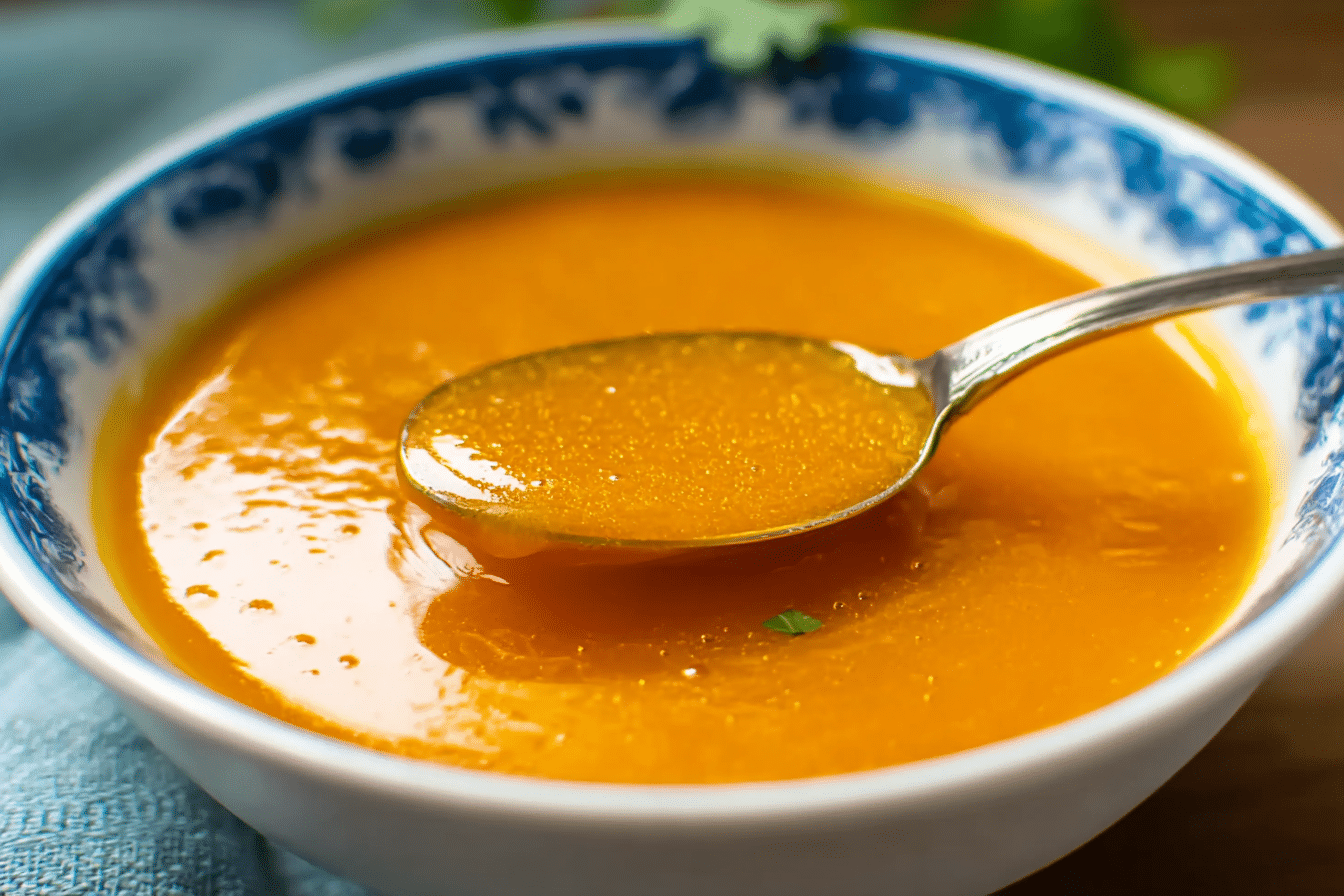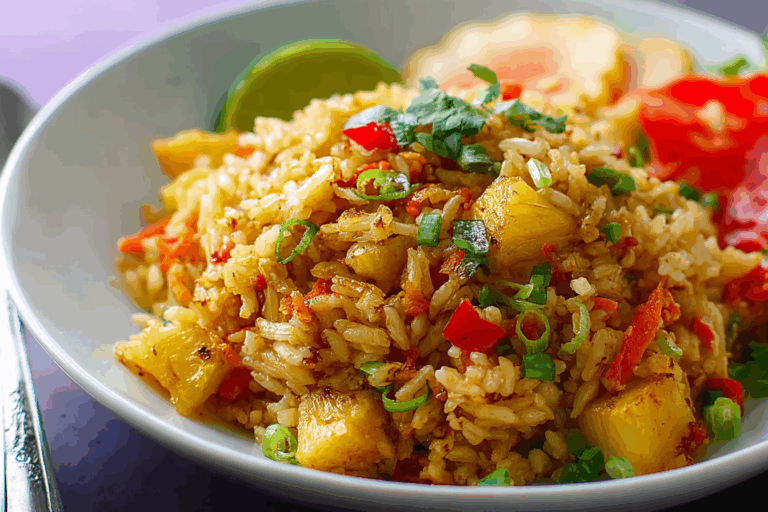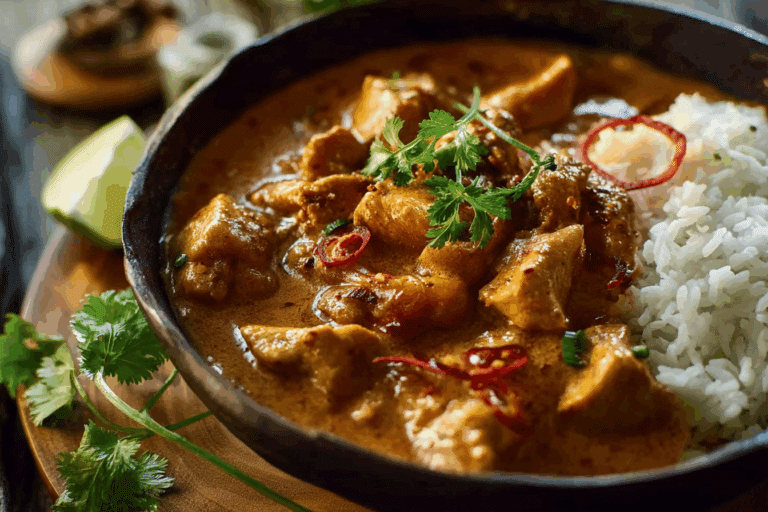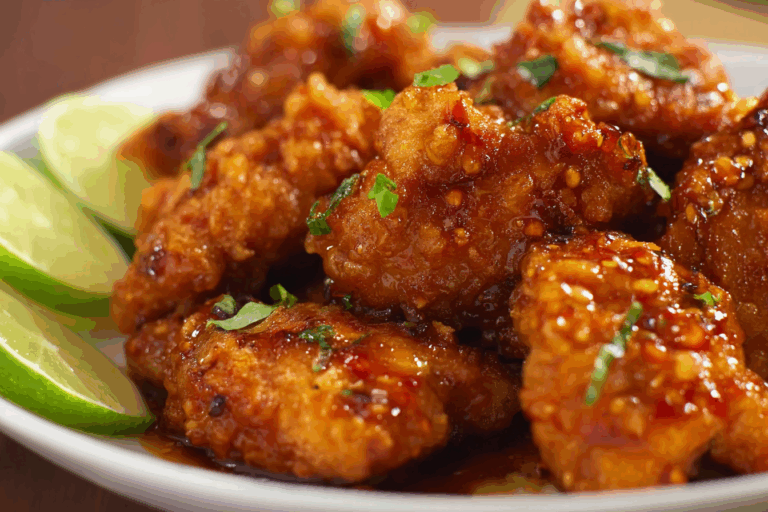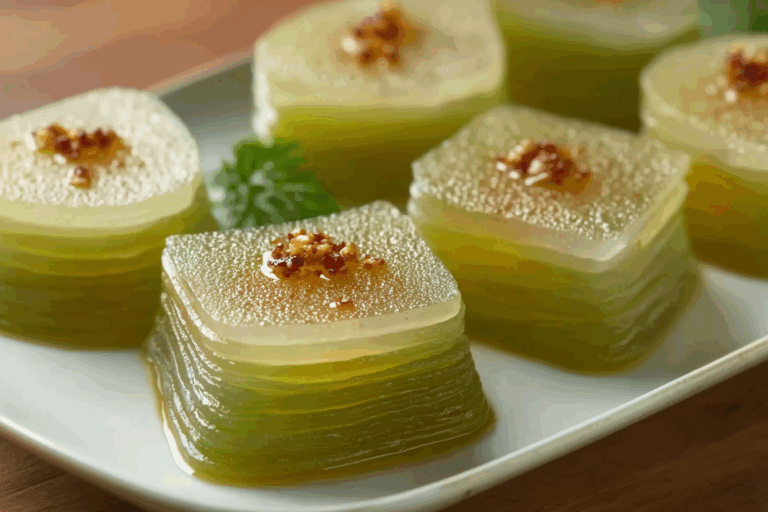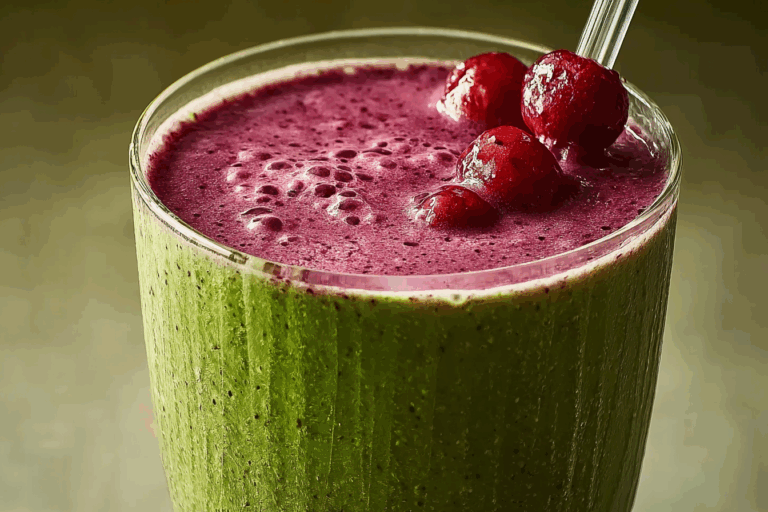Thai Pumpkin Coconut Soup: Learn How To Prepare It
At Just Thai Recipes, where tradition meets modern Thai home cooking, every spoonful of a dish has a story. Our story begins with love for authentic Thai flavors deeply rooted in the memories of local street food stalls, home kitchens in Bangkok, and vibrant night markets where recipes are passed down through generations. If you’ve read our About page, you already know our mission is simple: bring real Thai flavor into every home kitchen around the world.
One of the recipes that perfectly captures the heart of Thai cuisine is this Thai Pumpkin Coconut Soup. It’s rich, creamy, and comforting with just the right amount of heat. Made with Thai red curry paste, fresh pumpkin, and full-fat coconut milk, this soup offers layers of flavor that go far beyond the typical pumpkin soup. It’s the kind of dish that transforms an ordinary night into something memorable.
Whether you’re a fan of Jamie Oliver’s pumpkin soup with coconut milk, hunting for the best pumpkin soup recipe ever, or curious about Thai curry pumpkin soup, this guide gives you everything you need. We’ll walk you through the ingredients, show you how to perfect the cooking method, and explore garnishes and side pairings that elevate this dish to something unforgettable.
By the end of this article, you’ll not only have a deeply flavorful soup recipe, but you’ll understand the secret behind why this Thai-inspired version is becoming a cold-weather staple in kitchens everywhere.
Check out How To Make Duck Noodle Soup while you’re here, another deeply comforting Thai dish.
Table of Contents
Table of Contents
What Makes Thai Pumpkin Coconut Soup So Special?
A Beautiful Balance of Thai Flavors
What truly sets Thai Pumpkin Coconut Soup apart is the intricate balance of flavors that Thai cuisine is known for. This isn’t just a creamy pumpkin puree—it’s a bold harmony of sweet, savory, spicy, and salty.
The Thai red curry paste serves as the flavor backbone. Made with lemongrass, galangal, garlic, shallots, and red chilies, this paste brings layers of warmth and depth that transform the soup from basic to brilliant. Using a high-quality curry paste like Maesri, which is widely recommended in Thai kitchens, ensures the foundation of your soup is packed with authentic taste.
On top of that, the fish sauce adds the salty umami richness that’s characteristic of Thai cooking. If you’re vegetarian or vegan, soy sauce or tamari makes a great substitute without sacrificing flavor.
How the Coconut Milk Adds Creamy Depth
Coconut milk in Thai cooking isn’t just a creamy filler. It’s a starring ingredient that cools and rounds out the intensity of spices. The best Thai pumpkin coconut soups use full-fat coconut milk, which gives the soup a luscious mouthfeel and a slightly sweet, nutty flavor that balances the heat from the curry paste.
When cooked together with the pumpkin, the coconut milk soaks into the flesh of the squash, making every bite rich and flavorful. Some recipes use light coconut milk, but for the best results, always go full-fat. Quality matters here. Lower-grade coconut milk can separate or taste watery, and that ruins the silky texture that makes this soup so comforting.
Don’t miss our Is Thai Boat Noodles with Beef the Most Delicious Thai Soup You Haven’t Tried Yet? to explore another rich and savory Thai broth experience.
Print
Thai Pumpkin Coconut Soup
- Prep Time: 10 minutes
- Cook Time: 20 minutes
- Total Time: 30 minutes
- Yield: 6 servings 1x
- Category: Soup
- Method: Simmering and Blending
- Cuisine: Thai
- Diet: Vegan
Description
Thai Pumpkin Coconut Soup is a creamy, spicy, and flavorful Thai-inspired soup made with red curry paste, coconut milk, and fresh pumpkin. Perfect for chilly nights or as a flavorful appetizer, this soup offers a comforting and aromatic experience in every spoonful.
Ingredients
- 2 tbsp vegetable oil (or other oil)
- 1 brown onion, diced
- 2 garlic cloves, finely minced
- 3 tbsp Thai red curry paste, Maesri recommended
- 1.8kg / 3.6 lb pumpkin or butternut squash – peeled, deseeded, and chopped into 3cm / 1.2″ chunks (~1.3 kg / 2.6 lb usable)
- 2 1/2 cups vegetable stock, salt reduced (or chicken stock)
- 400ml / 14 oz (1 can) coconut milk, full fat, best quality
- 1 tbsp fish sauce (substitute with light or regular soy sauce for vegetarian/vegan)
- Optional Garnishes: Crispy Asian shallots, finely sliced red cayenne pepper, fresh coriander leaves, pan-fried roti
Instructions
- Heat oil in a large heavy-based pot over medium-high heat.
- Add diced onion and minced garlic. Sauté for 2 minutes until soft and fragrant.
- Stir in Thai red curry paste and cook for 2 minutes to release its aroma and flavor.
- Add the chopped pumpkin and stir to coat with curry paste. Cook for another 2 minutes.
- Set aside 1/4 cup of coconut milk for garnish. Add the stock, remaining coconut milk, and fish sauce to the pot.
- Bring to a simmer, then reduce heat to medium and cook for 8 minutes or until pumpkin is soft.
- Use a stick blender to blend the soup until completely smooth and creamy.
- Serve hot, topped with reserved coconut milk and optional garnishes. Enjoy with roti for dipping.
Notes
- Use Maesri curry paste for authentic Thai flavor.
- Butternut squash, kabocha, or sugar pumpkin are ideal choices.
- Full-fat coconut milk provides the richest, creamiest texture.
- Fish sauce adds deep umami flavor, but soy sauce works well as a substitute.
- Crispy Asian shallots and roti are optional but highly recommended garnishes.
- This soup can be made ahead and stored for up to 4 days or frozen for 3 months.
Nutrition
- Serving Size: 1 bowl (approx. 1.5 cups)
- Calories: 280
- Sugar: 6g
- Sodium: 460mg
- Fat: 20g
- Saturated Fat: 14g
- Unsaturated Fat: 5g
- Trans Fat: 0g
- Carbohydrates: 21g
- Fiber: 4g
- Protein: 3g
- Cholesterol: 0mg
Keywords: Thai Pumpkin Coconut Soup, Thai red curry soup, pumpkin coconut soup, vegan Thai soup, Thai curry soup, curried pumpkin soup, coconut milk pumpkin soup, Thai pumpkin curry
Key Ingredients for Authentic Thai Pumpkin Coconut Soup
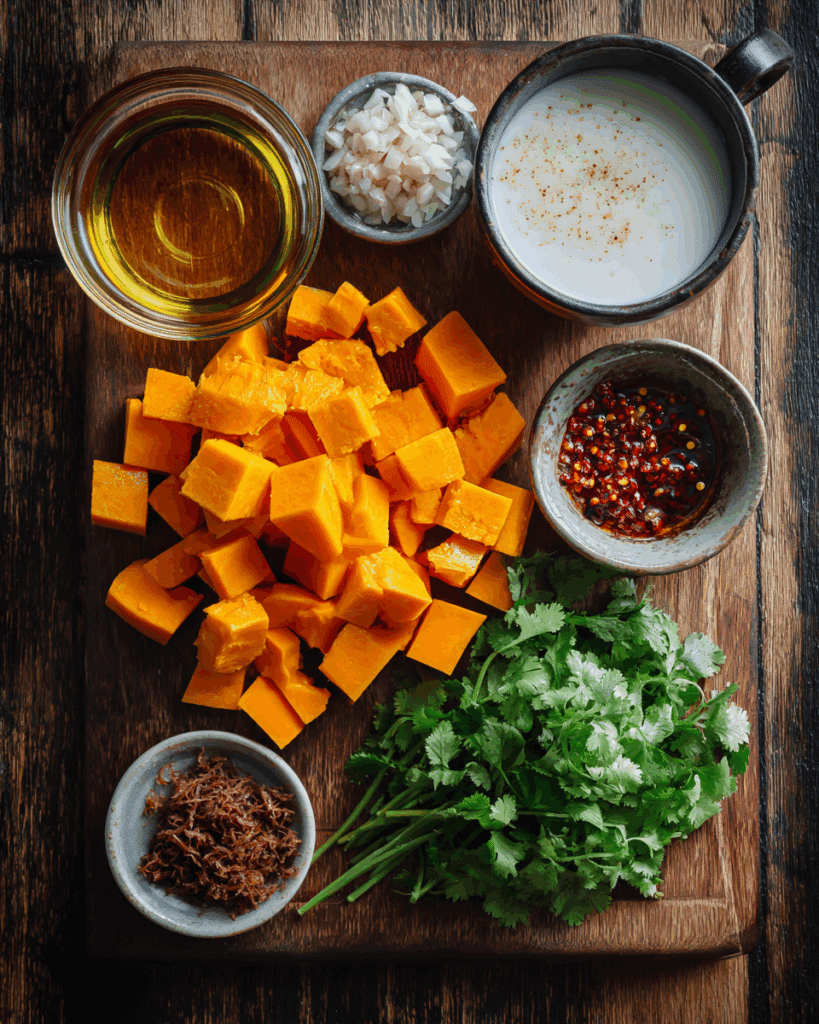
Choosing the Right Pumpkin
The heart of any pumpkin soup lies in the pumpkin itself. For Thai Pumpkin Coconut Soup, using the right type of pumpkin makes all the difference in texture and flavor. The most commonly used varieties include butternut squash, kabocha squash, or classic sugar pumpkins. These types offer a naturally sweet flavor and smooth texture when blended.
You’ll need about 1.8 kg (3.6 lb) of fresh pumpkin or squash, which becomes around 1.3 kg (2.6 lb) once peeled and deseeded. Make sure to cut the pumpkin into roughly 3cm (1.2″) chunks for even cooking. Avoid stringy or overly watery varieties, which can thin out the soup and weaken the flavor.
If you’re short on time, pre-cut pumpkin from the grocery store works too. Just be sure it’s fresh and not frozen to maintain flavor integrity.
Thai Red Curry Paste: Why Maesri is the Best Choice
No Thai Pumpkin Coconut Soup is complete without a good curry paste. It’s the soul of the dish. Among many available brands, Maesri Thai red curry paste is widely regarded as the most authentic and flavorful. It’s packed with bold aromatics like kaffir lime, coriander root, and dried red chilies that bring your soup to life.
Using 3 tablespoons of Maesri paste gives the perfect level of heat and flavor complexity. If you prefer a milder soup, you can adjust it down to 2 tablespoons, but don’t skip it altogether. Without the curry paste, the soup loses its distinctly Thai personality.
The Role of Coconut Milk and Stock
Coconut milk acts not just as a creamy base but as a flavor balancer. For this recipe, you’ll use 400ml (14 oz) of full-fat coconut milk. Avoid low-fat versions; they won’t deliver the same richness and often separate during cooking.
You’ll also need 2½ cups of vegetable or chicken stock. Opt for low-sodium versions so you can control the salt levels yourself. The stock helps thin the coconut milk just enough for a silky-smooth consistency.
Before blending, remember to set aside ¼ cup of coconut milk for garnishing. It adds a beautiful swirl on top and makes the soup look restaurant-quality.
Fish Sauce or Soy Sauce: Finding Umami Balance
Fish sauce adds deep umami notes that tie the whole soup together. Just 1 tablespoon is enough to enhance the savory layers without making it taste fishy. If you’re vegetarian, swap it with light soy sauce or tamari. The flavor profile changes slightly, but it still complements the pumpkin and coconut beautifully.
Looking for inspiration? Try How To Make Thai Red Rubies Dessert after your soup—it’s the perfect Thai sweet to follow a savory course.
Step-by-Step Cooking Instructions for Thai Pumpkin Coconut Soup
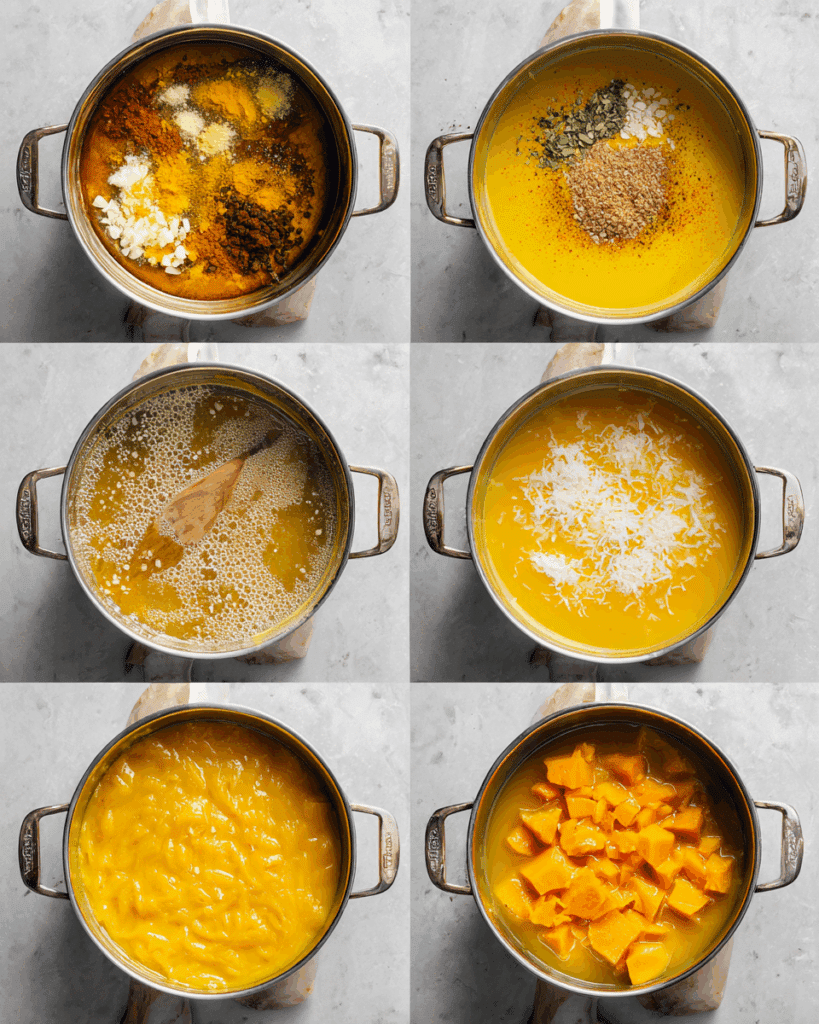
Step 1: Sauté Aromatics for Flavor Base
Start by heating 2 tablespoons of vegetable oil in a large, heavy-based pot over medium-high heat. Add 1 diced brown onion and 2 finely minced garlic cloves, then sauté for about 2 minutes until the onions turn translucent and aromatic.
This step may seem basic, but it builds the first layer of flavor. Avoid rushing it; undercooked onions can create bitterness, while overcooked ones lose their aroma. As the garlic hits the oil, it releases an unmistakable warmth that hints at what’s to come.
Step 2: Toast the Curry Paste
Add 3 tablespoons of Maesri Thai red curry paste to the pot. Cook it for another 2 minutes, stirring frequently so it doesn’t burn. This “toasting” process awakens the spices in the paste, releasing deeper aromas and intensifying the flavor.
You’ll notice a beautiful reddish oil separating from the paste, which is a good sign—it means the spices are activated. At this point, your kitchen will smell incredible.
Step 3: Add Pumpkin and Coat with Flavor
Next, toss in your chopped 1.3 kg (2.6 lb) pumpkin or butternut squash. Stir to coat the pumpkin pieces with the curry base. Let them cook for about 2 minutes, allowing the heat to start softening the edges and infuse the pumpkin with the flavors of garlic, onion, and curry paste.
This step makes a huge difference in flavor. It caramelizes the surface of the pumpkin just slightly, which helps it absorb more from the soup as it cooks.
Step 4: Simmer Until Tender
Now add the 2½ cups of vegetable or chicken stock, followed by the remaining coconut milk (except the ¼ cup reserved for garnish) and 1 tablespoon of fish sauce or soy sauce.
Bring everything to a gentle boil, then reduce the heat to medium and simmer for 8 minutes, or until the pumpkin is fork-tender. Don’t overcook it—the pumpkin should be soft enough to blend smoothly, but not falling apart into mush.
The soup will now have a rich, golden-orange hue and a luxurious scent that combines the sweetness of pumpkin with the savory warmth of curry and coconut.
Step 5: Blend for Creamy Perfection
Use a stick blender directly in the pot and puree the soup until smooth. If you’re using a countertop blender, let the soup cool slightly first and blend in batches to avoid splattering.
Once blended, the soup should be velvety smooth and thick but pourable. If it’s too thick, you can add a splash of warm stock or hot water to adjust the consistency.
Before serving, drizzle the reserved ¼ cup of coconut milk on top for a beautiful contrast in color and creaminess.
Step 6: Garnish and Serve
Now comes the fun part—garnishing. While optional, toppings take this soup to the next level:
- Crispy fried Asian shallots add crunch and savory depth
- Thinly sliced red cayenne pepper provides color and gentle heat
- Fresh coriander leaves give it that classic Thai freshness
- And if you want to go all-in Thai-style, serve it with flaky roti, pan-fried until golden—ideal for dunking
Discover great ideas like Thai Pineapple Fried Rice: Learn How To Make It for a flavorful side that pairs beautifully with this soup.
For more inspiration, explore how others put their spin on this dish:
- RecipeTin Eats has a robust and creamy version of Thai Coconut Pumpkin Soup that uses homemade curry paste
- Over at Love and Lemons, their Coconut Curry Pumpkin Soup offers a plant-based twist with added ginger
- Food & Wine‘s Thai Pumpkin Soup brings elegant simplicity to the bowl
- Or check out this refreshing take from Shift Nutrition with their Thai Pumpkin Coconut Soup that emphasizes whole foods
Variations and Dietary Adaptations for Thai Pumpkin Coconut Soup
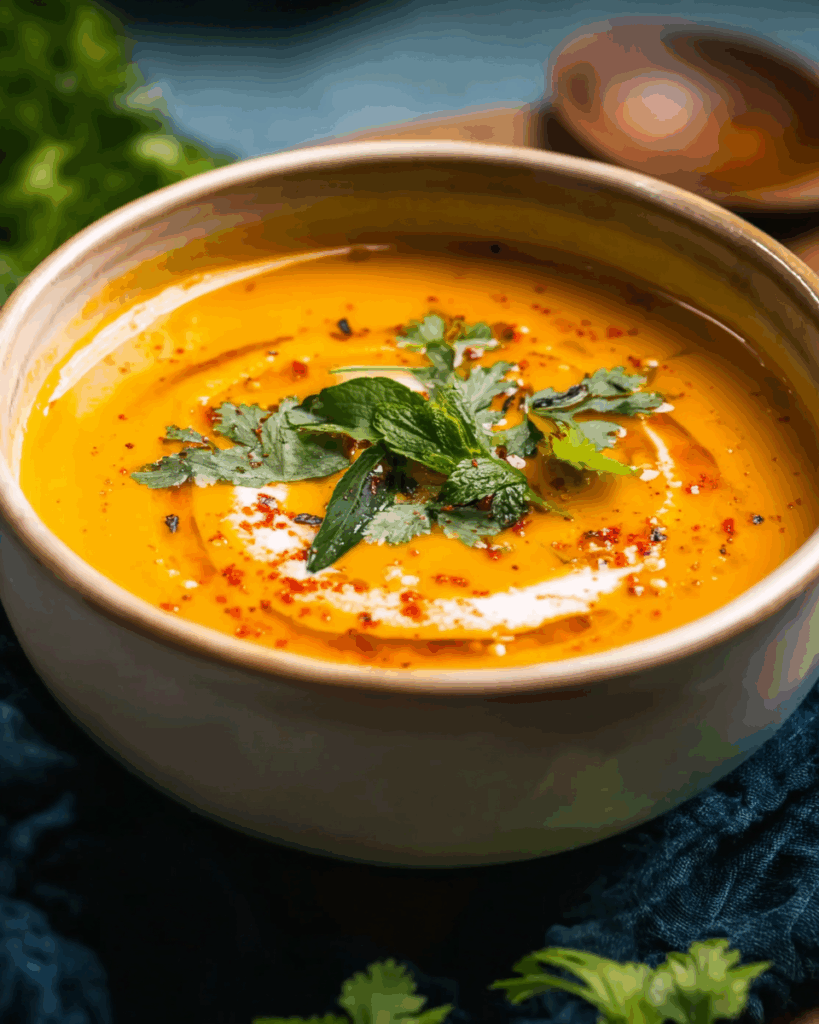
Making It Vegan or Vegetarian
One of the best things about Thai Pumpkin Coconut Soup is how easily it adapts to dietary needs. To make this soup fully vegan, simply replace the fish sauce with light soy sauce or tamari. Both options still add the necessary salty umami flavor that complements the pumpkin and coconut milk beautifully.
Many Thai recipes are naturally plant-based or can be made so with just one or two swaps. The soup’s core—pumpkin, coconut milk, red curry paste, and spices—is already vegan-friendly. Just double-check that your red curry paste contains no shrimp paste if you’re cooking for strict vegans.
Also, if you’re aiming for a gluten-free version, use tamari instead of soy sauce, and verify that your stock is gluten-free as well.
Adjusting Spice Levels for All Palates
Thai red curry paste brings a mild to medium heat depending on the brand and how much you use. If you’re cooking for kids or spice-sensitive guests, reduce the curry paste to 1 or 2 tablespoons. You can also stir in a bit more coconut milk at the end to mellow the heat without thinning the soup.
On the other hand, if you’re someone who enjoys a fiery bowl of soup, feel free to add some fresh Thai chilies during the sauté step or top with sliced red cayenne pepper for that extra kick. A few drops of chili oil just before serving also adds complexity.
Low-Sodium or Health-Conscious Adjustments
For those watching sodium intake, use low-sodium vegetable or chicken stock and reduced-salt soy sauce. The soup will still be flavorful thanks to the natural sweetness of the pumpkin and richness of the coconut milk. You can also cut down on oil slightly by using just one tablespoon to sauté the onions and garlic.
To boost nutrition, consider blending in cooked carrots or sweet potatoes for extra fiber and beta-carotene without changing the taste dramatically.
Adding Protein for a Complete Meal
This soup is hearty on its own, but you can add protein for a more filling meal. Try:
- Pan-seared tofu cubes: Tossed in soy sauce, they soak up the soup beautifully
- Shredded poached chicken: For a non-vegetarian version, it’s a simple and tasty addition
- Lentils: Add cooked red lentils during the blending stage for an earthy boost
These additions make the soup not only a starter but a satisfying main course.
Perfect Pairings and Side Dishes for Thai Pumpkin Coconut Soup
Why Pairings Matter for Thai Soups
While Thai Pumpkin Coconut Soup is flavorful and hearty on its own, pairing it with the right sides can elevate your meal from a simple lunch to a full, satisfying dining experience. The goal of a good pairing is to contrast and complement the creamy, mildly spicy, and slightly sweet profile of the soup without overpowering it.
Because this soup is rich and velvety, light, crisp, and fresh accompaniments make the best match. These sides add texture, brightness, and sometimes a tangy note to balance out the creaminess of the coconut milk and the depth of the red curry.
Best Breads for Dunking and Dipping
One of the most popular pairings with Thai Pumpkin Coconut Soup is roti, especially the flaky, pan-fried type. Its crisp layers contrast perfectly with the smooth texture of the soup. If you can find frozen roti at your local Asian market, just pan-fry it in a little oil until golden brown and serve warm for dipping.
Other great bread options include:
- Grilled naan: Similar in softness and chew to roti, with a slightly smoky flavor
- Garlic toast: Offers crunch and a garlicky bite that plays well with the curry notes
- Crusty sourdough: Its tanginess contrasts beautifully with the sweet pumpkin
Avoid overly soft breads like white sandwich bread, which can become soggy quickly and lose their appeal when dipped.
Rice Dishes That Balance and Fill
Thai jasmine rice is a classic choice for any Thai soup. Its subtle floral aroma and fluffy texture pair well with the richness of the coconut milk. You can also serve the soup over a scoop of steamed rice to turn it into a more filling dish, like a curry bowl.
For something more colorful and complex, try coconut rice. The mild sweetness of coconut rice complements the pumpkin in the soup without being too repetitive.
Brown rice or red rice is another great option if you’re looking for more fiber and a nuttier flavor. These whole grains also add a nice chew that contrasts with the silky soup.
Light Sides to Refresh the Palate
Balance is key in Thai cuisine. Since the soup is rich and velvety, serving it with something bright and fresh helps refresh the palate. Consider:
- Cucumber salad with lime and chili: The cool crunch of cucumber with a splash of lime cuts through the soup’s creaminess
- Pickled vegetables: Their acidity and sharpness add a different kind of punch
- Fresh Thai herbs: Basil, mint, and cilantro can be offered in a small side dish for guests to sprinkle on top of their soup as desired
These refreshing elements not only enhance the flavor but also give the meal a vibrant, restaurant-quality feel.
How to Store, Freeze, and Reheat Thai Pumpkin Coconut Soup
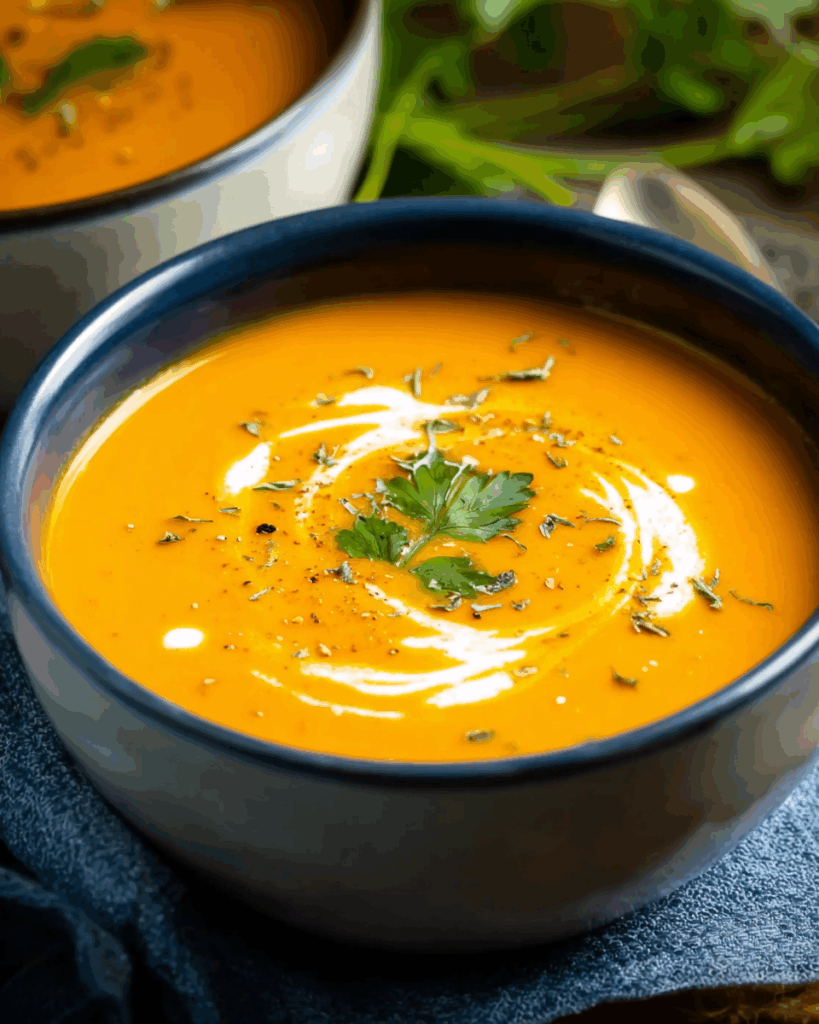
Storing Leftovers Properly
One of the great things about Thai Pumpkin Coconut Soup is that it stores exceptionally well. In fact, many people say the flavor improves after a day as the spices have more time to meld and deepen.
To store leftovers, let the soup cool to room temperature before transferring it into an airtight container. Store in the refrigerator for up to 4 days. Keep the garnishes (like fried shallots or herbs) separate so they remain crisp when you’re ready to serve again.
If you’ve reserved extra coconut milk for garnish, keep that portion in a separate small container in the fridge. Give it a quick stir before drizzling over the reheated soup.
Freezing for Longer Storage
Thai Pumpkin Coconut Soup also freezes beautifully. The high-fat content from the coconut milk and the fiber-rich pumpkin help maintain the creamy texture even after freezing and thawing.
Here’s how to do it right:
- Cool the soup completely before freezing
- Store in freezer-safe containers or heavy-duty zip-top bags
- Leave at least an inch of space at the top of the container for expansion
- Label with the date and use within 3 months for the best flavor
Avoid freezing with garnishes like fresh herbs or crispy shallots, as their texture won’t hold up. You can always add those fresh after reheating.
How to Reheat Without Losing Flavor
When it’s time to enjoy your frozen Thai Pumpkin Coconut Soup, you have a few options:
- Stovetop: Pour the soup into a saucepan and reheat on medium-low heat, stirring occasionally to prevent it from sticking. If the texture feels too thick after freezing, add a splash of warm water or vegetable stock to loosen it up.
- Microwave: Use a microwave-safe bowl and cover loosely. Heat on high for 2–3 minutes, stirring halfway through to ensure even warming.
Make sure the soup is heated thoroughly to steaming temperature, especially if it contains added protein like chicken or tofu.
Reheating tip: Wait to add salt or extra soy sauce until after the soup is hot, since the flavors can become more concentrated after storage. Taste before adjusting seasonings.
Make-Ahead Tips for Meal Prep
If you’re planning meals for the week, Thai Pumpkin Coconut Soup is a perfect candidate. You can cook a large batch on the weekend and portion it into individual containers for grab-and-go lunches or quick dinners.
To streamline the process:
- Pre-chop pumpkin and store it in the fridge 2 days ahead
- Make the soup base (onion, garlic, curry paste) and refrigerate it in a sealed jar
- Use a meal prep day to cook, blend, and portion the soup for the week
Add fresh garnishes and warm roti just before serving to keep everything vibrant and fresh.
Comparing Thai Pumpkin Coconut Soup to Other Popular Pumpkin Soups
How Thai Pumpkin Coconut Soup Stands Out
When you think of classic pumpkin soup, most versions lean heavily on Western ingredients like cream, butter, and nutmeg. But Thai Pumpkin Coconut Soup breaks away from that mold entirely. It’s not just another creamy bowl of pureed pumpkin—it’s a flavor explosion rooted in Thai culinary traditions.
What makes it unique is the use of Thai red curry paste, full-fat coconut milk, and fish sauce. These elements introduce heat, umami, and richness that most traditional Western pumpkin soups lack. While both styles are warming and comforting, Thai Pumpkin Coconut Soup delivers complexity in every spoonful.
The inclusion of curry paste adds a savory, spicy layer that lingers pleasantly on the palate. Coconut milk then smooths it out with a sweet, nutty creaminess, while fish sauce or soy sauce ties the flavors together with deep umami undertones.
Comparing with Jamie Oliver’s Pumpkin Soup with Coconut Milk
Jamie Oliver’s take on pumpkin soup with coconut milk leans toward global fusion. While his recipe often includes ginger, lemongrass, and garlic—ingredients commonly found in Thai cuisine—his flavor balance is more subtle.
In contrast, Thai Pumpkin Coconut Soup uses bolder quantities of red curry paste, more intense aromatics, and balances sweetness with the savory edge of fish sauce. It’s less about a gentle blend and more about a punchy, satisfying contrast of flavors.
Both are delicious, but if you’re looking for a vibrant, spicy, deeply aromatic dish, the Thai version is the clear winner.
Differences from Curried Pumpkin Soup
Curried pumpkin soup is another close cousin of Thai Pumpkin Coconut Soup. Many versions use curry powder or garam masala to bring heat and spice, usually in combination with cream or yogurt. However, curry powder is typically Indian in profile, relying on spices like cumin, turmeric, and coriander.
Thai Pumpkin Coconut Soup, by contrast, takes a Southeast Asian approach. Its red curry paste contains lemongrass, kaffir lime leaves, galangal, and dried chili—all distinctively Thai. The result is more fragrant and slightly more acidic due to lime elements, giving it a fresher taste overall.
Curried pumpkin soup may be rich and warming, but Thai Pumpkin Coconut Soup adds brightness and layers that elevate it beyond basic comfort food.
Why It’s the Best Pumpkin Soup Recipe Ever (For Many)
Many home cooks and foodies believe Thai Pumpkin Coconut Soup is the best pumpkin soup recipe ever—and it’s easy to see why. It checks every box:
- Comforting and hearty
- Rich and creamy without being heavy
- Bursting with bold, balanced flavors
- Easy to prepare with common pantry ingredients
- Adaptable for vegans, vegetarians, and gluten-free diets
You get heat without it being overwhelming, creaminess without dairy, and complexity without needing a professional kitchen.
If you’ve tried basic pumpkin soups and felt they were missing something, this Thai version is likely what you’ve been looking for. It’s not just about warming up—it’s about waking up your palate.
Common Mistakes to Avoid When Making Thai Pumpkin Coconut Soup
Using the Wrong Type of Pumpkin or Squash
One of the most frequent mistakes home cooks make when preparing Thai Pumpkin Coconut Soup is using the wrong kind of pumpkin. While any pumpkin might technically “work,” not all are ideal for the creamy, silky texture this soup is known for. Avoid watery or fibrous pumpkins, as they can make the soup thin or grainy. Instead, choose dense, sweet varieties like butternut squash, kabocha, or sugar pumpkin.
These types roast and simmer beautifully and break down into a smooth, naturally sweet base that complements the spicy red curry and creamy coconut milk. A poor pumpkin choice results in a bland or watery final product, undermining the unique richness Thai Pumpkin Coconut Soup is known for.
Skimping on the Curry Paste
Another common issue is not using enough Thai red curry paste. The curry paste is the flavor engine of Thai Pumpkin Coconut Soup, and using just a teaspoon or two won’t give you the bold Thai flavor that makes this dish memorable. You need at least 2 to 3 tablespoons of high-quality paste—ideally from a brand like Maesri—to bring out the authentic taste.
Toasting the paste in oil before adding any liquids is also essential. This activates the spices and deepens the flavor. Skipping this step leaves the soup tasting flat, even if all the other ingredients are correct.
Using Low-Fat Coconut Milk
Many people substitute full-fat coconut milk with light versions, assuming it will make the dish healthier. While lighter coconut milk may cut a few calories, it sacrifices the signature creamy richness that defines Thai Pumpkin Coconut Soup. Worse yet, low-fat versions can split or separate during cooking, resulting in a curdled appearance and uneven texture.
Always use full-fat coconut milk for the best results. It emulsifies smoothly, balances the spice, and delivers the luxurious mouthfeel that makes the soup so comforting.
Overcooking the Pumpkin
Timing matters. Simmering the pumpkin too long can cause it to lose its sweetness and flavor. You want the pumpkin just tender enough to blend, not mushy or falling apart. Typically, 8 minutes of simmering is sufficient after adding the stock and coconut milk.
Overcooked pumpkin can also make the soup overly thick or dull in flavor. If it’s been sitting too long in the pot, you might end up needing to thin it out with extra stock—diluting the richness you worked hard to build.
Forgetting to Season at the End
Salt levels can fluctuate as the soup cooks, especially if you’re using stock or fish sauce. A common mistake is assuming it’s seasoned just right without tasting before serving. Always taste and adjust salt, fish sauce, or soy sauce at the end.
A final splash of lime juice (optional but encouraged) can brighten everything, adding a subtle acidity that cuts through the creaminess of the coconut milk and intensifies the Thai flavor.
By avoiding these mistakes, your Thai Pumpkin Coconut Soup will consistently deliver restaurant-level quality, making it a go-to favorite for cold nights, dinner parties, or meal prep.
Conclusion: Why Thai Pumpkin Coconut Soup Deserves a Spot in Your Recipe Rotation
Thai Pumpkin Coconut Soup is more than just a bowl of soup—it’s a complete sensory experience. From the vibrant orange hue of the pumpkin to the rich aroma of red curry and coconut milk rising from your bowl, this dish captures the essence of comforting Thai cuisine. It’s warming, satisfying, and bursting with flavor, yet surprisingly simple to prepare.
What makes this soup stand out isn’t just its ingredients—though pumpkin, coconut milk, and Thai curry paste are an unbeatable trio—but the way those ingredients work together to create something that’s greater than the sum of its parts. The creamy texture soothes the palate while the red curry delivers just enough heat to keep things exciting. And with every bite, you get the balanced contrast of sweet, savory, spicy, and aromatic that Thai food is known for.
Whether you’re serving it as a starter at a dinner party, preparing a cozy weeknight meal, or batch cooking for your weekly meal prep, Thai Pumpkin Coconut Soup adapts beautifully to every occasion. It stores well, reheats wonderfully, and offers flexibility for a range of dietary preferences—including vegan, gluten-free, and low-sodium diets.
Once you try this soup, you’ll find it’s not just another seasonal dish—it’s one of those timeless recipes you’ll come back to again and again. It’s proof that comfort food can be bold, vibrant, and deeply nourishing.
FAQs About Thai Pumpkin Coconut Soup
Is Thai Pumpkin Coconut Soup vegan?
It can be. The base ingredients of Thai Pumpkin Coconut Soup—pumpkin, coconut milk, and Thai red curry paste—are naturally plant-based. The one ingredient that may not be vegan is fish sauce, which is used to add salty umami depth. To make the soup vegan, simply substitute fish sauce with light soy sauce, tamari, or even coconut aminos. Make sure to also choose a curry paste that does not contain shrimp paste.
How spicy is Thai Pumpkin Coconut Soup?
The spiciness of Thai Pumpkin Coconut Soup depends largely on the amount and type of red curry paste used. Using 2 to 3 tablespoons of Maesri red curry paste will deliver a mild to medium heat. If you’re spice-sensitive, you can reduce it to 1 tablespoon or add more coconut milk at the end to mellow the heat. For extra spice, try topping your bowl with sliced red chilies or a drizzle of chili oil.
Can I make Thai Pumpkin Coconut Soup ahead of time?
Absolutely. In fact, many people say Thai Pumpkin Coconut Soup tastes even better the next day. The flavors deepen and meld after a night in the fridge. Simply store it in an airtight container for up to 4 days. When reheating, do so gently over medium-low heat to avoid separating the coconut milk. You can also freeze it for up to 3 months. Just remember to store garnishes like crispy shallots and fresh herbs separately.
What type of pumpkin is best for Thai Pumpkin Coconut Soup?
The best pumpkins for Thai Pumpkin Coconut Soup are those with a sweet, dense, and non-watery flesh. Butternut squash, kabocha squash, and sugar pumpkin are top choices. These varieties cook down to a silky texture and blend well with coconut milk and curry paste. Avoid watery pumpkins or those used primarily for carving, as they won’t yield the creamy consistency or sweetness needed to balance the savory flavors of Thai cuisine.

